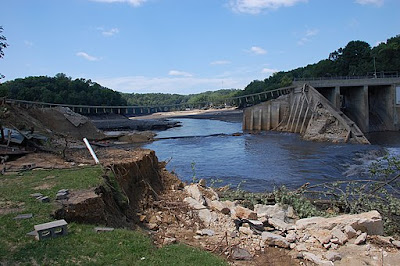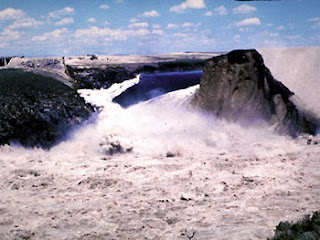Earthquake Hazards: Dam Failure
If you live downstream, a dam failure should be a concern for you. While many dams are built to a high seismic rating, there are many which are not.
The only way to discover a dam’s seismic rating is to do some investigating as you probably won’t find it stamped anywhere on the dam structure itself. There may be some plans in place in case of a failure, but most of the time these contingencies are based more on minor failures and not a catastrophic, complete failure, which could cause widespread flooding devastation.
The following image is of a dam failure (not earthquake caused) in Iowa.
 |
| Dam failure in Iowa. Photo by Josh deBerge, FEMA, public domain |
Dam Fails
However, it seems that some dams may be overrated on the integrity of the dam’s superstructure, and don’t give much credence to the possibility of complete failure. It’s true that most of the time dams do not suffer a complete failure. But there are been unexpected failures.
While not caused by a seismic event, the Teton Dam collapse on June 5, 1976, was completely unexpected. The dam had been completed less than a year earlier and was filling, almost to its capacity, when the failure occurred.
 |
| Water pouring from the Teton Dam failure on June 5, 1976. Pubic domain. |
More recently, in February 2017, the Oroville Dam in California became overwhelmed when heavy rainfall damaged the main spillway. Erosion threatened a collapse of the concrete weir which would have sent a 30-foot wall of water crashing into and flooding those downstream. Thankfully the dam did not fail, but it was clearly not designed to handle the water flow it did.
The key takeaway is the failure was not the result of the dam structure itself, which was an earthen dam, but most likely due to the failure in the abutments of the dam, allowing water to seep around and eventually cause the dam’s collapse.
The following photo shows water surging spectacularly down the eroded overflow spillway on the Oroville Dam.
 |
| Water surging down Oroville Dam spillway. William Croyle, California Department of Water Resources / Public domain Similarly, the dam structure itself may have an earthquake rating it was constructed to survive, but what about where the dam joins the ground at either end, the abutments? What happens if those fail? Or, could a landslide into the reservoir cause a seiche of significant size to wash over the dam? The point is, if you are downstream from a dam you should be aware of the possibility of a dam failure. You may not have much warning time to evacuate, especially if the electricity and communication systems are down as a result of the earthquake. I live near a river and there are two dams upstream. While both dams are supposed to be seismically resistant, with one dam having been rebuilt and reinforced several years ago, what happens if one of both dams becomes damaged? What happens if the abutments in the upper dam fail and the reservoir pours downstream to overwhelm the second reservoir? If that happens, most of the city I live in would experience some flooding. And we may be lucky, if communications are up and we're paying attention, to get 30 minutes warning. In the immediate aftermath of an earthquake there's not much option we have except to move everyone to the upper level and pray the nearby freeway will act as a dike to divert most of the water flow away from us. |

Comments
Post a Comment